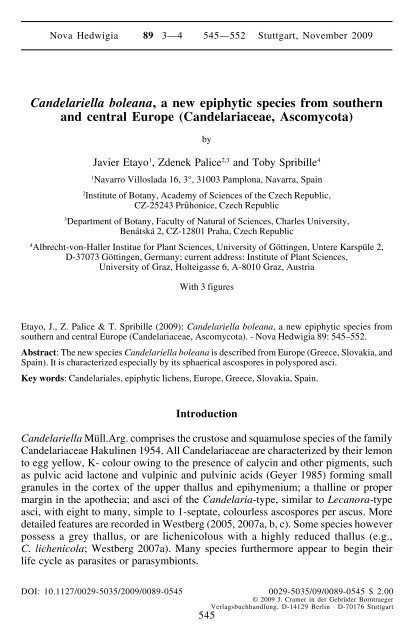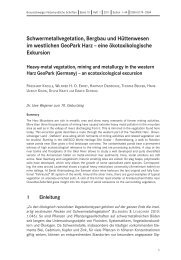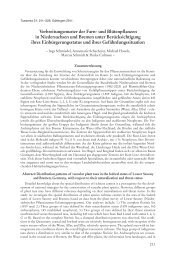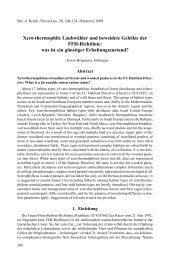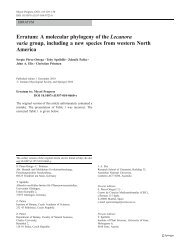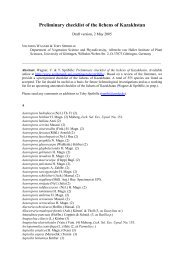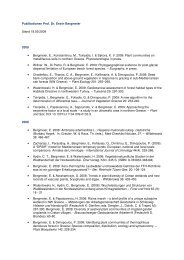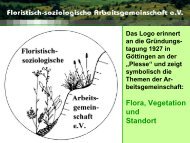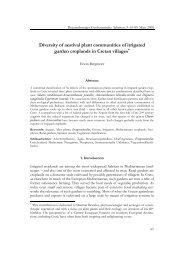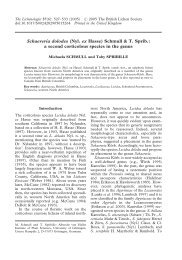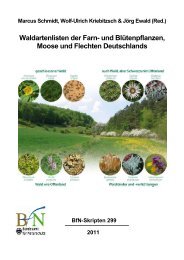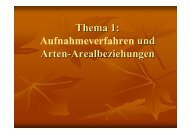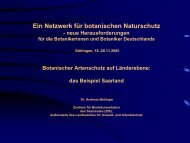Candelariella boleana, a new epiphytic species from southern and ...
Candelariella boleana, a new epiphytic species from southern and ...
Candelariella boleana, a new epiphytic species from southern and ...
You also want an ePaper? Increase the reach of your titles
YUMPU automatically turns print PDFs into web optimized ePapers that Google loves.
eschweizerbartxxx ingenta<br />
Nova Hedwigia 89 3—4 545—552 Stuttgart, November 2009<br />
<strong>C<strong>and</strong>elariella</strong> <strong>boleana</strong>, a <strong>new</strong> <strong>epiphytic</strong> <strong>species</strong> <strong>from</strong> <strong>southern</strong><br />
<strong>and</strong> central Europe (C<strong>and</strong>elariaceae, Ascomycota)<br />
by<br />
Javier Etayo 1 , Zdenek Palice 2,3 <strong>and</strong> Toby Spribille 4<br />
1<br />
Navarro Villoslada 16, 3°, 31003 Pamplona, Navarra, Spain<br />
2<br />
Institute of Botany, Academy of Sciences of the Czech Republic,<br />
CZ-25243 Průhonice, Czech Republic<br />
3<br />
Department of Botany, Faculty of Natural of Sciences, Charles University,<br />
Benátská 2, CZ-12801 Praha, Czech Republic<br />
4<br />
Albrecht-von-Haller Institue for Plant Sciences, University of Göttingen, Untere Karspüle 2,<br />
D-37073 Göttingen, Germany; current address: Institute of Plant Sciences,<br />
University of Graz, Holteigasse 6, A-8010 Graz, Austria<br />
With 3 figures<br />
Etayo, J., Z. Palice & T. Spribille (2009): <strong>C<strong>and</strong>elariella</strong> <strong>boleana</strong>, a <strong>new</strong> <strong>epiphytic</strong> <strong>species</strong> <strong>from</strong><br />
<strong>southern</strong> <strong>and</strong> central Europe (C<strong>and</strong>elariaceae, Ascomycota). - Nova Hedwigia 89: 545–552.<br />
Abstract: The <strong>new</strong> <strong>species</strong> <strong>C<strong>and</strong>elariella</strong> <strong>boleana</strong> is described <strong>from</strong> Europe (Greece, Slovakia, <strong>and</strong><br />
Spain). It is characterized especially by its sphaerical ascospores in polyspored asci.<br />
Key words: C<strong>and</strong>elariales, <strong>epiphytic</strong> lichens, Europe, Greece, Slovakia, Spain.<br />
Introduction<br />
<strong>C<strong>and</strong>elariella</strong> Müll.Arg. comprises the crustose <strong>and</strong> squamulose <strong>species</strong> of the family<br />
C<strong>and</strong>elariaceae Hakulinen 1954. All C<strong>and</strong>elariaceae are characterized by their lemon<br />
to egg yellow, K- colour owing to the presence of calycin <strong>and</strong> other pigments, such<br />
as pulvic acid lactone <strong>and</strong> vulpinic <strong>and</strong> pulvinic acids (Geyer 1985) forming small<br />
granules in the cortex of the upper thallus <strong>and</strong> epihymenium; a thalline or proper<br />
margin in the apothecia; <strong>and</strong> asci of the C<strong>and</strong>elaria-type, similar to Lecanora-type<br />
asci, with eight to many, simple to 1-septate, colourless ascospores per ascus. More<br />
detailed features are recorded in Westberg (2005, 2007a, b, c). Some <strong>species</strong> however<br />
possess a grey thallus, or are lichenicolous with a highly reduced thallus (e.g.,<br />
C. lichenicola; Westberg 2007a). Many <strong>species</strong> furthermore appear to begin their<br />
life cycle as parasites or parasymbionts.<br />
DOI: 10.1127/0029-5035/2009/0089-0545 0029-5035/09/0089-0545 $ 2.00<br />
© 2009 J. Cramer in der Gebrüder Borntraeger<br />
Verlagsbuchh<strong>and</strong>lung, D-14129 Berlin · D-70176 Stuttgart<br />
545
eschweizerbartxxx ingenta<br />
The genus <strong>C<strong>and</strong>elariella</strong> includes around 50 <strong>species</strong> world-wide. Several molecular<br />
phylogenetic studies (Wedin et al. 2005, Hofstetter et al. 2007, Miadlikowska et<br />
al. 2007) have demonstrated that C<strong>and</strong>elariaceae belong to a basal group of<br />
Lecanoromycetes recently raised to the level of order, as C<strong>and</strong>elariales Miadl.,<br />
Lutzoni & Lumbsch (Hibbett et al. 2007).<br />
Patellaria vitellina (Hoffmann 1794), <strong>from</strong> Germany, was the first description of<br />
a lichen belonging to this genus. <strong>C<strong>and</strong>elariella</strong> was monographed by Hakulinen<br />
(1954) for northern Europe. The taxonomy of this genus has remained relatively<br />
stable over the intervening 55 years (Rondon 1966, Poelt & Vězda 1976, 1977,<br />
Harris & Buck 1978, Clauzade & Roux 1985, Purvis et al. 1992). Along with the<br />
exploration of previously poorly known areas, several <strong>new</strong> <strong>species</strong> have been added<br />
during the last two decades: Nimis et al. (1989) described C. faginea <strong>from</strong> Fagus<br />
in Italy; Thor & Wirth (1990) described C. viae-lacteae <strong>from</strong> Populus, Pinus <strong>and</strong><br />
an unrecognized deciduous tree <strong>from</strong> Greece <strong>and</strong> Hungary; <strong>and</strong> Khodosovtev et al.<br />
(2004) described C. boikoi <strong>from</strong> the steppe shrub Halocnemum strobilaceum in<br />
the <strong>southern</strong> Ukraine <strong>and</strong> Astrakhan region of Russia <strong>and</strong> a shrub in the botanical<br />
garden of Almaty, Kazakhstan. Recently, Vondrák et al. (2008) reported the New<br />
World <strong>and</strong> Australasian C. antennaria as <strong>new</strong> to Europe <strong>from</strong> Crete. Recently<br />
Westberg (2007a, b, c) studied the genus in the western United States, describing<br />
several <strong>new</strong> <strong>species</strong>.<br />
Working on Crete two years earlier, the third author, writing in Spribille et al.<br />
(2006), reported as '<strong>C<strong>and</strong>elariella</strong> sp. 1' a taxon with sphaerical ascospores which<br />
appeared to be undescribed, <strong>and</strong> subsequently collected the <strong>species</strong> on the Greek<br />
mainl<strong>and</strong> in the Pindos Mountains. In both cases material was scant, <strong>and</strong> he refrained<br />
<strong>from</strong> publishing the <strong>species</strong> formally. He later learned that the same <strong>species</strong> was<br />
recognized by the first author as early as 1993 in material <strong>from</strong> Spain, <strong>and</strong> collected<br />
by the second author in Slovakia in 2007. We describe it here as a <strong>new</strong> <strong>species</strong>.<br />
Materials <strong>and</strong> methods<br />
Characteristics of the apothecia <strong>and</strong> thallus were investigated by light microscopy on h<strong>and</strong>-cut<br />
sections, mounted in water <strong>and</strong>/or 10% KOH (hereafter K), <strong>and</strong> stained with I Lugol<br />
(Merck 1.09261).<br />
Photos were taken with a Zeiss AxioCam MRc5 digital camera mounted on a Leica Wild M3Z stereo<br />
dissecting scope <strong>and</strong> digitally optimized using CombineZM freeware. Microscopic measurements<br />
were made at 1000× magnification in water <strong>and</strong> are given as smallest single measurement- largest<br />
single measurement. Thin layer chromatography (TLC) followed the st<strong>and</strong>ardized methods outlined<br />
by Culberson (1972) with modifications following Culberson & Johnson (1982).<br />
The <strong>species</strong><br />
<strong>C<strong>and</strong>elariella</strong> <strong>boleana</strong> Etayo, Palice & T.Sprib., sp. nov. Figs 1, 2<br />
MYCOBANK NUMBER: MB 513429<br />
Thallus granulosus, citrinus, 0.05–0.15 mm crassus. Algae unicellulares, 9–20 μm crassae, ad<br />
Chlorococcaceae pertinentes. Apothecia rotundata, basi leviter constricta, lecanorina, 0.2–0.4 mm in<br />
diametro, discus flavidus, planus vel convexus. Hypothecium hyalinum; hymenium 60–70 μm altum.<br />
546
eschweizerbartxxx ingenta<br />
Fig. 1. <strong>C<strong>and</strong>elariella</strong> <strong>boleana</strong>. Habit (Spribille 13250). Scale bar = 0.5 mm.<br />
Epihymenium granulis-luteis tectum. Asci late ellipsoidei, tholis distinctis instructi, I+ coerulescentes,<br />
35–52 × 14–20 μm, 16–32 sporas continentes. Ascosporae globulares, hyalinae, 4–5.5 μm magnae.<br />
TYPUS: Spain, Huesca, Central Pyrenees, Biescas, valle de Asieso, Barranco de Sta. Elena, 30TYN2126,<br />
Pinus sylvestris trunk, 1100 m, 5 August 1993, J.Etayo 13812 & A.Gómez-Bolea (BCC-Lich. -<br />
holotypus, herb. Etayo - isotypus).<br />
Thallus of scattered, small, yellowish to greenish, convex granules, 0.05–0.15 mm<br />
diam., not forming a rimose crust, lacking prothallus; algae Chlorococcaceae,<br />
individual cells 9–20 μm diam.. Apothecia 0.2–0.4 mm diam., scattered to aggregated,<br />
flat to convex when old, bright yellow, with yellow pruina; margin persistent to<br />
evanescent with clusters of algae (5–10 μm diam.) in lower part. Hypothecium<br />
colourless. Epihymenium yellow-brown, granular. Hymenium 60–70 μm tall,<br />
colourless, I+ blue. Paraphyses simple or scarcely branched, not or slightly swollen<br />
at the apices, 2–2.5 μm thick. Asci clavate, 35–52 × 14–20 μm, with 16–32 spores,<br />
C<strong>and</strong>elaria-type. Ascospores colourless, globose, simple, uniguttulate, 4–5.5 μm<br />
diam. Conidiomata not seen.<br />
CHEMISTRY: pulvinic acid only detected by TLC.<br />
REMARKS: <strong>C<strong>and</strong>elariella</strong> <strong>boleana</strong> is the only <strong>species</strong> known in the genus with orbicular<br />
spores, 16–32 per ascus, <strong>and</strong> can thus be easily distinguished all other <strong>species</strong>,<br />
including other corticolous <strong>and</strong> polysporous <strong>species</strong> such as C. lutella (Vain.) Räsänen,<br />
547
eschweizerbartxxx ingenta<br />
Fig. 2. <strong>C<strong>and</strong>elariella</strong> <strong>boleana</strong>. Asci at different stages of development, in Lugol’s solution; ascospores<br />
in ascus <strong>and</strong> paraphyses (<strong>from</strong> holotype). Scale bar = 10 μm.<br />
C. vitellina (Hoffm.) Müll.Arg. <strong>and</strong> C. xanthostigma (Ach.) Lettau. These <strong>species</strong><br />
have typically ellipsoidal spores. Its yellowish colour makes it difficult to confuse<br />
with other polysporic <strong>species</strong> with similarly shaped ascospores. Similar ascospores<br />
can be found in Biatoridium monasteriense J. Lahm ex Körber, but that <strong>species</strong><br />
differs in several additional features, especially the ascus-type, number of spores per<br />
ascus (c. 100), <strong>and</strong> their size, 2.5–3.5 μm diam. (Hafellner 1994). Perhaps some<br />
samples that have been determined as this <strong>species</strong> by European lichenologists belong<br />
to C. <strong>boleana</strong>. Alstrup (1993) described a <strong>new</strong> <strong>species</strong> in the Lecanora fuscescens<br />
group <strong>from</strong> Greenl<strong>and</strong>, L. polysphaeridia with identical ascospores <strong>and</strong> number per<br />
ascus, but the ascus-type <strong>and</strong> colour of thallus <strong>and</strong> apothecia are different, as well as<br />
the ecology (dry twigs <strong>and</strong> leaves of Cassiope). Among the corticolous <strong>and</strong> polysporous<br />
<strong>C<strong>and</strong>elariella</strong> <strong>species</strong>, C. <strong>boleana</strong> differs <strong>from</strong> all presently known <strong>species</strong> in its<br />
sphaerical ascospores.<br />
<strong>C<strong>and</strong>elariella</strong> <strong>boleana</strong> is the second <strong>species</strong> of C<strong>and</strong>elariaceae to be recognized that<br />
has sphaerical spores. The only other <strong>species</strong> known to have these kinds of ascospores<br />
is C<strong>and</strong>elaria sphaerobola Poelt & Reddi, a microfoliose <strong>species</strong> <strong>from</strong> eastern Nepal<br />
(Poelt & Reddi 1969). C. sphaerobola differs primarily in its completely different<br />
gross thallus morphology (foliose versus granular-crustose in C. <strong>boleana</strong>).<br />
Based on a phylogenetic study using ITS rDNA sequence data (Westberg et al.<br />
2007), the genus <strong>C<strong>and</strong>elariella</strong> as currently circumscribed appears to be paraphyletic.<br />
The three remaining genera of C<strong>and</strong>elariaceae (C<strong>and</strong>elaria, C<strong>and</strong>elina, Placomaronea)<br />
are nested within <strong>C<strong>and</strong>elariella</strong>. The mutual relationships of single<br />
monophyletic groups within C<strong>and</strong>elariaceae remain unresolved. So far molecular<br />
data appear to be only partially congruent with morphology. The relationship of<br />
C. <strong>boleana</strong> to other <strong>C<strong>and</strong>elariella</strong> <strong>species</strong> remains unknown, but based on overall<br />
548
eschweizerbartxxx ingenta<br />
Fig. 3. Known distribution of <strong>C<strong>and</strong>elariella</strong> <strong>boleana</strong>.<br />
gross morphology <strong>and</strong> anatomy, it appears C. <strong>boleana</strong> could be related to the type<br />
<strong>species</strong> of the genus, C. vitellina (see Westberg et al. 2007) with preserved proper<br />
margin, polysporous asci <strong>and</strong> finely granulose to areolate thallus. This however<br />
should be confirmed by molecular studies.<br />
HABITAT AND DISTRIBUTION: <strong>C<strong>and</strong>elariella</strong> <strong>boleana</strong> is known <strong>from</strong> a small number of<br />
widely disjunct localities in Europe (Fig. 3). In the Spanish Pyrenees (Huesca <strong>and</strong><br />
Navarra), it has been found in Pinus sylvestris <strong>and</strong> Quercus woods at elevations of<br />
850 to 1200 m. In Greece it was found on Cupressus sempervirens <strong>and</strong> Juniperus<br />
foetidissima at elevations of 1050 to 1150 m. In Slovakia the <strong>species</strong> was collected<br />
twice on the same locality on bark of Quercus in a well-lit xerothermic oak wood<br />
(Quercus dalechampii <strong>and</strong> Q. polycarpa dominating) on limestone bedrock in National<br />
Park Muránska planina (Western Carpathians) at approximately 550 m. This<br />
extraordinary region hosts or used to host several <strong>southern</strong> lichen <strong>species</strong> with<br />
otherwise more <strong>southern</strong> distributions. The putative northernmost European<br />
distributional limit is reached here by, e.g., Calicium montanum, Caloplaca adriatica,<br />
Leptogium hildenbr<strong>and</strong>ii, Physconia servitii <strong>and</strong> Rinodina polysporoides (Pišút 1990,<br />
Guttová & Palice 2005, Palice et al. 2006). In Slovakia <strong>and</strong> Spain, associated lichens<br />
occurring with <strong>C<strong>and</strong>elariella</strong> <strong>boleana</strong> include Acrocordia gemmata, Agonimia<br />
tristicula, Am<strong>and</strong>inea punctata, Buellia griseovirens, Caloplaca cerina s.lat.,<br />
C. flavorubescens, C. holocarpa s.lat., <strong>C<strong>and</strong>elariella</strong> vitellina, C. xanthostigma,<br />
549
eschweizerbartxxx ingenta<br />
Catillaria nigroclavata, Lecanora pulicaris, Lecidea nyl<strong>and</strong>eri, Lecidella elaeochroma<br />
s.lat. (incl. var. soralifera), Pertusaria albescens <strong>and</strong> Scoliciosporum umbrinum.<br />
C. <strong>boleana</strong> has been probably overlooked on account of its small size, but even so,<br />
it is likely not a common <strong>species</strong>. C. <strong>boleana</strong> was collected once in northern Greece<br />
in 2005, but during two weeks of collecting in the same area the following year, it<br />
was not found again. Also, despite knowing of the <strong>species</strong>, in the case of the first<br />
author for over fifteen years, we have seen only eight collections. Slovak specimens<br />
were growing side by side with occasionally fertile specimens of C. xanthostigma,<br />
<strong>and</strong> it is possible that these two <strong>species</strong> may occur more frequently together. The<br />
<strong>new</strong> <strong>species</strong> may well be hidden in herbaria intermingled with that <strong>species</strong>.<br />
<strong>C<strong>and</strong>elariella</strong> <strong>boleana</strong> is named in honour of the lichenologist <strong>and</strong> friend Dr. Antonio<br />
Gómez-Bolea. The word “<strong>boleana</strong>” also recalls the Spanish word “bola”, or ball,<br />
much like the ascospore shape of C. <strong>boleana</strong>.<br />
ADDITIONAL MATERIAL EXAMINED: GREECE: Crete, Levka Ori, trail S of Omalos <strong>from</strong> Xiloskalo towards<br />
Gingilos, 35°18'N, 23°54'E, T.Spribille 13250 (GZU); ibid., S.Abrahamczyk s.n. (B); Epirus, Arta<br />
prefecture, road between Voulgareli <strong>and</strong> Agnanta, on side road up the W slopes of Tsouma Katí,<br />
39°23'N, 21°07'E, T.Spribille 16418 (GZU); SLOVAKIA: W Carpathians, Muránska planina, Poludnica<br />
nature reserve, N-S oriented crest S of Maretkiná game-keeper-house, 48°45'N, 20°01'E, A.Guttová,<br />
J.Halda & Z.Palice 11452 (PRA, BG, UPS); ibid., P.Czarnota, A.Guttová, J.Halda & Z.Palice<br />
12471 (PRA, SAV); SPAIN: Navarra, Aranarache, 30TWN6337, J.Etayo 10106 (hb. Etayo); Huesca,<br />
Biescas, hayedo de Betato, 30TYN1931, J.Etayo & A.Gómez-Bolea (Hb. Etayo 12718).<br />
Acknowledgements<br />
We thank Sergio Pérez-Ortega (Madrid) for comments on an earlier version of the manuscript.<br />
Walter Obermayer (Graz) helped improve the photos. Greek collections were made in the course of<br />
excursions organized <strong>and</strong> led by Erwin Bergmeier of the University of Göttingen, Germany. Slovak<br />
specimens originated <strong>from</strong> annual field trips organized by Anna Guttová (Bratislava). ZP acknowledges<br />
support by the Academy of the Czech Republic (AV0Z60050516) <strong>and</strong> the Ministry of Education,<br />
Youth <strong>and</strong> Sports of the Czech Republic (no. 0021620828). Christian Printzen (Frankfurt am Main)<br />
prepared the distribution map.<br />
References<br />
ALSTRUP, V. (1993): News on lichens <strong>and</strong> lichenicolous fungi <strong>from</strong> the Nordic countries.<br />
- Graphis Scripta 5: 96–104.<br />
CLAUZADE, G. & C. ROUX (1985): Likenoj de Okcidenta Eùropo. Illustrita Determinlibro.<br />
- Bull. Soc. Bot. Centre-Ouest, Nouv. Sér., Num. Spéc. 7: 1–893.<br />
CULBERSON, C.F. (1972): Improved conditions <strong>and</strong> <strong>new</strong> data for the identification of lichen<br />
products by a st<strong>and</strong>ardized thin-layer chromatographic method. - J. Chromatography 72: 113–125.<br />
CULBERSON, C.F. & A. JOHNSON (1982): Substitution of methyl tert.-butyl ether for diethyl<br />
ether in the st<strong>and</strong>ardized thin-layer chromatographic method for lichen products. - J. Chromatography<br />
238: 483–487.<br />
GEYER, M. (1985): Hochdruck-Flüssigkeits-Chromatographie (HPLC) von Flechten - Sekundärstoffen.<br />
- Doctoral dissertation. University of Essen, Essen.<br />
GUTTOVÁ, A. & Z. PALICE (2005): Lišajníky Národného parku Muránska planina III - Cigánka.<br />
- Reussia 1, Suppl. 1/2004: 5–40.<br />
550
eschweizerbartxxx ingenta<br />
HAFELLNER, J. (1994): On Biatoridium, a resurrected genus of lichenized fungi (Ascomycotina,<br />
Lecanorales). - Acta Bot. Fennica 150: 39–46.<br />
HAKULINEN, R. (1954): Die Flechtengattung <strong>C<strong>and</strong>elariella</strong> Müller Argoviensis, mit besonderer<br />
Berücksichtigung ihres Auftretens und ihrer Verbreitung in Fennosk<strong>and</strong>ien. - Ann. Bot. Soc. Zool.<br />
Bot. Fenn. “Vanamo” 27/3: i–vi + 1–127.<br />
HARRIS, R.C. & W.R. BUCK (1978): Lichens of the Mackinac Straits Region. II. <strong>C<strong>and</strong>elariella</strong><br />
Müll. Arg. - Mich. Bot. 17: 155–161.<br />
HIBBETT, D.S., M. BINDER, J.F. BISCHOFF, M. BLACKWELL, P.F. CANNON,<br />
O.E. ERIKSSON, S. HUHNDORF, T. JAMES, P.M. KIRK, R. LÜCKING, H.T. LUMBSCH,<br />
F. LUTZONI, P.B. MATHENY, D.J. MCLAUGHLIN, M.J. POWELL, S. REDHEAD,<br />
C.L. SCHOCH, J.W. SPATAFORA, J.A. STALPERS, R. VILGALYS, M.C. AIME,<br />
A. APTROOT, R. BAUER, D. BEGEROW, G.L. BENNY, L.A. CASTLEBURY, P.W. CROUS,<br />
Y.C. DAI, W. GAMS, D.M. GEISER, G.W. GRIFFITH, C. GUEIDAN, D.L. HAWKSWORTH,<br />
G. HESTMARK, K. HOSAKA, R.A. HUMBER, K.D. HYDE, J.E. IRONSIDE, U. KÕLJALG,<br />
C.P. KURTZMAN, K.H. LARSSON, R. LICHTWARDT, J. LONGCORE, J. MIĄDLIKOWSKA,<br />
A. MILLER, J.-M. MONCALVO, S. MOZLEY-STANDRIDGE, F. OBERWINKLER,<br />
E. PARMASTO, V. REEB, J.D. ROGERS, C. ROUX, L. RYVARDEN, J.P. SAMPAIO,<br />
A. SCHÜSSLER, J. SUGIYAMA, R.G. THORN, L. TIBELL, W.A. UNTEREINER, C. WALKER,<br />
Z. WANG, A. WEIR, M. WEISS, M.M. WHITE, K. WINKA, Y.-J. YAO & N. ZHANG (2007):<br />
A higher-level phylogenetic classification of the Fungi. - Mycol. Res. 111: 509–547.<br />
HOFFMANN, G.F. (1794): Descriptio et adumbratio plantarum e classe cryptogamica Linnaei,<br />
quae Lichenes dicuntur 2. - Leipzig.<br />
HOFSTETTER, V., J. MIADLIKOWSKA, F. KAUFF & F. LUTZONI (2007): Phylogenetic<br />
comparison of protein-coding versus ribosomal RNA-coding sequence data: A case study of the<br />
Lecanoromycetes (Ascomycota). - Mol. Phylog. Evol. 44: 412–426.<br />
KHODOSOVTSEV, A., S. KONDRATYUK & I. KÄRNEFELT (2004): <strong>C<strong>and</strong>elariella</strong> boikoi,<br />
a <strong>new</strong> lichen <strong>species</strong> <strong>from</strong> Eurasia. - Graphis Scripta 16: 11–15.<br />
MIADLIKOWSKA J., F. KAUFF, V. HOFSTETTER, E. FRAKER, M. GRUBE, J. HAFELLNER,<br />
V. REEB, B.P. HODKINSON, M. KUKWA, R. LÜCKING, G. HESTMARK, M.G. OTALORA,<br />
A. RAUHUT, B. BÜDEL, C. SCHEIDEGGER, E. TIMDAL, S. STENROOS, I. BRODO,<br />
G.B. PERLMUTTER, D. ERTZ, P. DIEDERICH, J.C. LENDEMER, P. MAY, C.L. SCHOCH,<br />
A.E. ARNOLD, C. GUEIDAN, E. TRIPP, R. YAHR, C. ROBERTSON & F. LUTZONI (2007)<br />
['2006']: New insights into classification <strong>and</strong> evolution of the Lecanoromycetes (Pezizomycotina,<br />
Ascomycota) <strong>from</strong> phylogenetic analyses of three ribosomal RNA- <strong>and</strong> two protein-coding genes.<br />
- Mycologia 98: 1088–1103.<br />
NIMIS, P.L., J. POELT & D. PUNTILLO (1989): <strong>C<strong>and</strong>elariella</strong> faginea spec. nov. (Lichenes,<br />
C<strong>and</strong>elariaceae) eine bemerkenswerte neue Art einer schwierigen Gattung aus Südeuropa. – Nova<br />
Hedwigia 49: 274–280.<br />
PALICE, Z., A. GUTTOVÁ & J.P. HALDA (2006): Lichens <strong>new</strong> for Slovakia collected in the<br />
National Park Muránska planina (W Carpathians). - In: LACKOVIČOVÁ, A., A.GUTTOVÁ ,<br />
E. LISICKÁ & P. LIZOŇ (eds.), Central European lichens - diversity <strong>and</strong> threat, p. 179–192,<br />
Mycotaxon Ltd., Ithaca.<br />
PIŠÚT, I. (1990): Nachträge zur Kenntnis der Flechten der Slowakei 12. - Zborn. Slov. Múz. Prír.<br />
Vedy, Bratislava 36: 9–13.<br />
POELT, J. & B.V. REDDI (1969). C<strong>and</strong>elaria und <strong>C<strong>and</strong>elariella</strong>. Lichenes, C<strong>and</strong>elariaceae (Flechten<br />
des Himalaya 4). - Khumbu Himal. 6: 1–16.<br />
POELT, J. & A. VĚZDA (1976). <strong>C<strong>and</strong>elariella</strong> plumbea und C. rhodax sp. novae, zwei neue Arten<br />
der europäischen Flechten-Flora. - Folia Geobot.Phytotax. 11: 87–92.<br />
551
eschweizerbartxxx ingenta<br />
POELT, J. & A. VĚZDA (1977). Bestimmungsschlüssel europäischer Flechten. Ergänzungsheft I.<br />
- Bibl. Lichenol. 9: 1–258.<br />
PURVIS, O.W., B.J. COPPINS, D.L. HAWKSWORTH, P.W. JAMES & D.M. MOORE (eds.)<br />
(1992): The Lichen flora of Great Britain <strong>and</strong> Irel<strong>and</strong>. - Natural History Museum Publications,<br />
London.<br />
RONDON, Y. (1966): Une espece nouvelle de lichen: <strong>C<strong>and</strong>elariella</strong> oleaginescens nov. spec.<br />
- Rev. Bryol. Lichénol. 34: 831–832.<br />
SPRIBILLE, T., M. SCHULTZ, O. BREUSS & E. BERGMEIER (2006): Notes on the lichens <strong>and</strong><br />
lichenicolous fungi of western Crete (Greece). - Herzogia 19: 125–148.<br />
THOR, G. & V. WIRTH (1990): <strong>C<strong>and</strong>elariella</strong> viae-lacteae, a <strong>new</strong> lichen <strong>species</strong> <strong>from</strong> Europe.<br />
- Stuttg. Beitr. Naturk., Ser. A 445: 1–4.<br />
VONDRÁK, J., A. GUTTOVÁ & H. MAYRHOFER (2008): A further contribution to the knowledge<br />
of lichen-forming <strong>and</strong> lichenicolous fungi in Crete. - Herzogia 21: 105–124.<br />
WEDIN, M., E. WIKLUND, A. CREWE, H. DÖRING, S. EKMAN, Å. NYBERG, I. SCHMITT<br />
& H.T. LUMBSCH (2005): Phylogenetic relationships of Lecanoromycetes (Ascomycota) as revealed<br />
by analyses of mtSSU <strong>and</strong> nLSU rDNA sequence data. - Mycol. Res. 109: 159–172.<br />
WESTBERG, M. (2005): The lichen genus <strong>C<strong>and</strong>elariella</strong> in western North America. - Department<br />
of Ecology. Plant Ecology <strong>and</strong> Systematics. Lund University.<br />
WESTBERG, M. (2007a): <strong>C<strong>and</strong>elariella</strong> (C<strong>and</strong>elariaceae) in western United States <strong>and</strong> northern<br />
Mexico: the <strong>species</strong> with biatorine apothecia. - Bryologist 110: 365–374.<br />
WESTBERG, M. (2007b): <strong>C<strong>and</strong>elariella</strong> (C<strong>and</strong>elariaceae) in western United States <strong>and</strong> northern<br />
Mexico: the polysporous <strong>species</strong>. - Bryologist 110: 375–390.<br />
WESTBERG, M. (2007c): <strong>C<strong>and</strong>elariella</strong> (C<strong>and</strong>elariaceae) in western United States <strong>and</strong> northern<br />
Mexico: the 8-spored, lecanorine <strong>species</strong>. - Bryologist 110: 391–419.<br />
WESTBERG, M., U. ARUP & I. KÄRNEFELT (2007): Phylogenetic studies in the C<strong>and</strong>elariaceae<br />
(lichenized Ascomycota) based on nuclear ITS DNA sequence data. - Mycol. Res. 111: 1277–1284.<br />
Received 22 May 2009, acepted in revised form 9 June 2009.<br />
552


